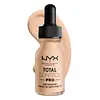NYX Cosmetics Total Control Pro Drop Skin-True Buildable Vegan Foundation Versus Idun Minerals Moisturizing Mineral Skin Tint SPF30
What's inside
What's inside
 Key Ingredients
Key Ingredients

 Benefits
Benefits

No benefits
 Concerns
Concerns

 Ingredients Side-by-side
Ingredients Side-by-side

Water
Skin ConditioningC13-15 Alkane
SolventZinc Oxide
Cosmetic ColorantC12-15 Alkyl Benzoate
AntimicrobialPropanediol
SolventPolyglyceryl-6 Polyricinoleate
EmulsifyingPentylene Glycol
Skin ConditioningDisteardimonium Hectorite
StabilisingDistarch Phosphate
AbsorbentZinc Stearate
Cosmetic ColorantPolyglyceryl-2 Isostearate
EmulsifyingTriethoxycaprylylsilane
Ceramide AP
Skin Conditioning1,2-Hexanediol
Skin ConditioningMagnesium Sulfate
Sodium Benzoate
MaskingSodium Dehydroacetate
PreservativeSodium Myristoyl Glutamate
CleansingLecithin
EmollientAluminum Hydroxide
EmollientTocopherol
AntioxidantAscorbyl Palmitate
AntioxidantStearic Acid
CleansingCitric Acid
BufferingCI 77891
Cosmetic ColorantCI 77492
Cosmetic ColorantCI 77491
Cosmetic ColorantCI 77499
Cosmetic ColorantWater, C13-15 Alkane, Zinc Oxide, C12-15 Alkyl Benzoate, Propanediol, Polyglyceryl-6 Polyricinoleate, Pentylene Glycol, Disteardimonium Hectorite, Distarch Phosphate, Zinc Stearate, Polyglyceryl-2 Isostearate, Triethoxycaprylylsilane, Ceramide AP, 1,2-Hexanediol, Magnesium Sulfate, Sodium Benzoate, Sodium Dehydroacetate, Sodium Myristoyl Glutamate, Lecithin, Aluminum Hydroxide, Tocopherol, Ascorbyl Palmitate, Stearic Acid, Citric Acid, CI 77891, CI 77492, CI 77491, CI 77499
 Reviews
Reviews

Ingredients Explained
These ingredients are found in both products.
Ingredients higher up in an ingredient list are typically present in a larger amount.
Aluminum Hydroxide is a form of aluminum. It can be naturally found in nature as the mineral gibbsite. In cosmetics, Aluminum Hydroxide is used as a colorant, pH adjuster, and absorbent.
As a colorant, Aluminum Hydroxide may add opacity, or reduce the transparency. Aluminum hydroxide is contains both basic and acidic properties.
According to manufacturers, this ingredient is an emollient and humectant. This means it helps hydrate the skin.
In medicine, this ingredient is used to help relieve heartburn and help heal ulcers.
There is currently no credible scientific evidence linking aluminum hydroxide in cosmetics to increased cancer risk.
Major health organizations allow the use of aluminum hydroxide in personal care products and have not flagged it as a carcinogenic risk at typical usage levels.
Learn more about Aluminum HydroxideCi 77491 is also hydrated iron III oxide. It's sole purpose is to give a red/pink hue to products.
Iron III oxides are classified as inorganic chemicals for coloring.
Synthetically created Ci 77491 is considered safer than those naturally found. This is because the synthetically created version may contain less impurities. Iron oxides are generally non-toxic and non-allergenic.
Learn more about CI 77491Ci 77492 is also hydrated iron III oxide. It's sole purpose is to give a yellow hue to products.
Iron III oxides are classified as inorganic chemicals for coloring.
Synthetically created Ci 77492 is considered safer than those naturally found. This is because the synthetically created version may contain less impurities. Iron oxides are generally non-toxic and non-allergenic.
Learn more about CI 77492Ci 77499 is also hydrated iron III oxide. It is created from mixing red and black iron oxides. This helps give shades of darkness to a product.
Iron III oxides are classified as inorganic chemicals for coloring.
Ci 77891 is a white pigment from Titanium dioxide. It is naturally found in minerals such as rutile and ilmenite.
It's main function is to add a white color to cosmetics. It can also be mixed with other colors to create different shades.
Ci 77891 is commonly found in sunscreens due to its ability to block UV rays.
Learn more about CI 77891